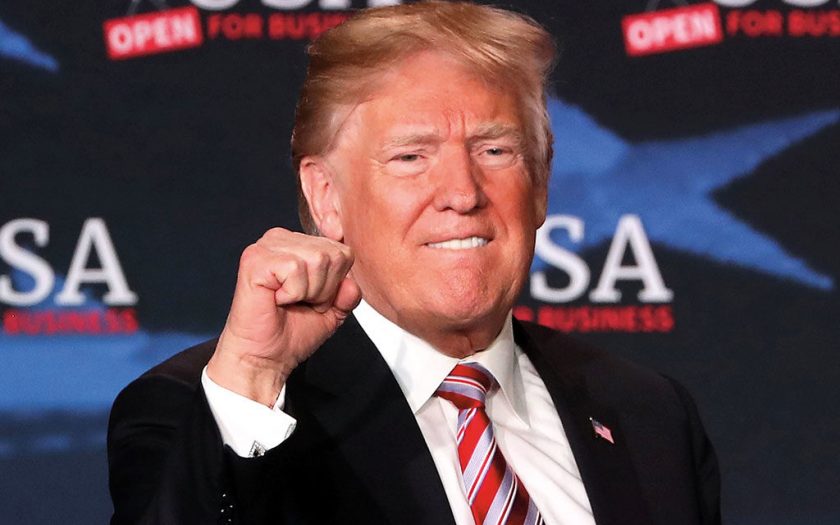
This article is taken from our FREE daily investment email Money Morning.
Every day, MoneyWeek’s executive editor John Stepek and guest contributors explain how current economic and political developments are affecting the markets and your wealth, and give you pointers on how you can profit.
.
In this week’s issue of MoneyWeek magazine
●
Why brands and ideas are the route to reliable profits
●
The Baltic states: throwing off a history of conflict and communism
●
The easy way to back value stocks
●
Ring up profits with these three traditional retail stocks
●
The best cards to use for holiday spending
● Share tips of the week
Not a subscriber? Sign up here
Global stockmarkets had a rough day yesterday.
Investors are starting to get the jitters about global trade tensions. We’re still in the phoney war stage, but the fear that things will heat up is rising.
Investors can’t quite wrap their heads around what Donald Trump’s administration is trying to achieve.
And that’s not surprising, really, as it’s not clear that they know either.
It’s not clear what the next batch of trade restrictions might look like
Despite what you might fear from the headlines, global trade has not collapsed. Not yet, anyway.
According to Capital Economics, latest data from the Netherlands shows that global trade volume rose by 0.7% in April, after falling in both of the previous two months. Other measures are less encouraging – growth in air freight traffic and sea container volumes is slowing sharply.
But overall, it’s not a particularly ugly picture. “Trade figures from early-reporting and highly-open economies, like Taiwan and Singapore… show that export volumes rose further in May.” Meanwhile, Chinese exports and imports have both recovered in the past month. In general, global growth appears to be pretty healthy.
The question is: will increasing trade tensions between the US and China derail this in some way?
The latest bout of nerves came amid concerns that the US government will prevent China from investing in US companies working with sensitive technology.
US Treasury Secretary Steven Mnuchin made things worse, reports the FT, by saying that the restrictions “would not be China-specific, but rather a broader attempt to limit foreign investment in sensitive US technologies.”
Then, the particularly protectionist trade adviser Peter Navarro said that the market should calm down, and that there were in fact no plans for wider restrictions at all.
“All this president wants is free, fair, reciprocal trade. And by taking a tough stand on countries that have high tariff barriers or restrict our investment, that is going to take us to a better place.”
That helped markets to recover from the lows. But it’s very clear that the risks are rising. The White House is meant to be unveiling a new range of trade and investment barriers by 30 June (in other words, this weekend).
And despite Navarro’s comments – which, given his history, are more likely to be aimed at propping up the market than giving any actual indication of what the new measures will be – it would be sensible to expect them to be framed aggressively, at the very least.
At the moment, Trump is in “tough guy” mode. In the absence of a “big win” that he can push to the electorate, he’s unlikely to shift tack. Whether China gives him that win remains to be seen.
Why big tech stocks could be hit hardest by global trade tensions
Interestingly, Ingvild Borgen Gjerde of Capital Economics argues that the big tech stocks (sorry, I just find that FAANG acronym irritating) could be among the most vulnerable stocks if trade tension picks up.
This might seem odd. After all, the companies involved – Amazon, Facebook, Google, the usual suspects – don’t rely much on suppliers from China, so their costs aren’t likely to go up by much.
Also, these companies don’t have a huge amount of sales exposure to China either, because China has its own social media empires. (If you’re running an authoritarian government, you really can’t allow something as critical as social media to be run by a bunch of unaccountable foreigners – which also, I suppose, raises questions about the correct role that regulation should play in governing social media over here.)
Back to the point: the big, hot tech stocks shouldn’t really be that bothered by trade tensions between China and the US because it doesn’t really directly affect them. That is probably another reason why these companies are still outperforming the wider market – as I’ve often said, no fund manager will get fired for owning Amazon today, and that’s why most of them own it, regardless of how expensive it is.
However – and it’s a big however – as Gjerde puts it, there is one thing that the big tech players are very vulnerable to. And that’s a wider economic slowdown.
“The FAANG’s revenue growth remains highly dependent on overall growth in the economy… once this falls, the FAANG’s profit growth will fall as well.”
In other words, they might not be exposed to China specifically, but they are exposed to the global slowdown that would result from a major escalation in trade tensions.
And on top of that, of course, they are both expensive and popular. When (because it is a case of when, not if) that changes, they will have further to fall than the least popular stocks in the market.
What does that mean in practice? I’m not suggesting you bail out of any tech holdings you have (I know a lot of you own the Scottish Mortgage investment trust, for example – unsurprisingly, as it’s in the MoneyWeek investment trust portfolio). All I’d say is that it might be worth looking at how US and tech-heavy your portfolio is right now – if it has significantly grown beyond your target allocations, it might be a good time to rebalance.